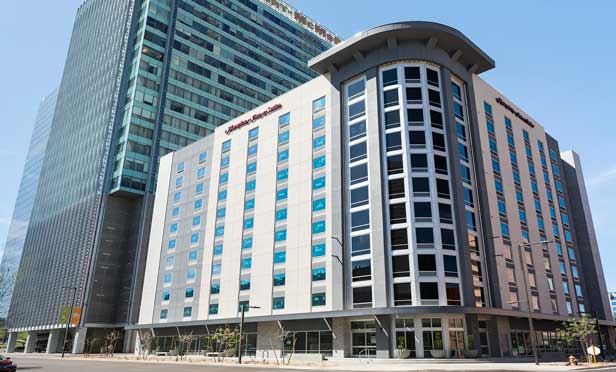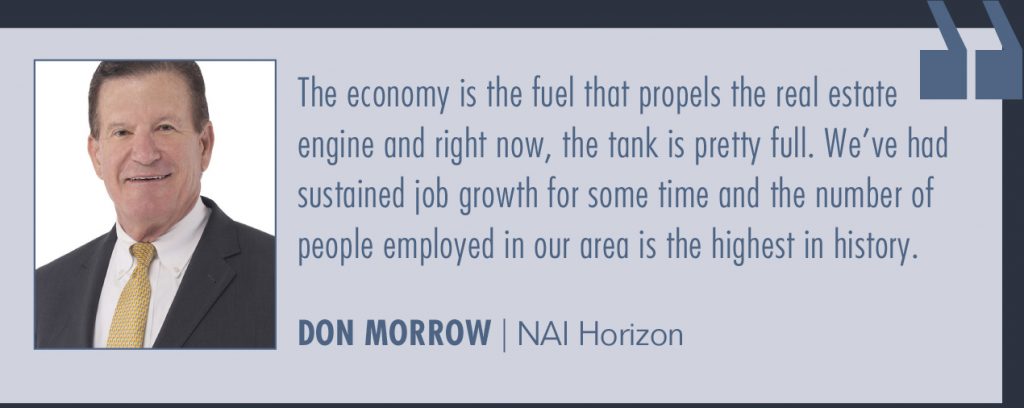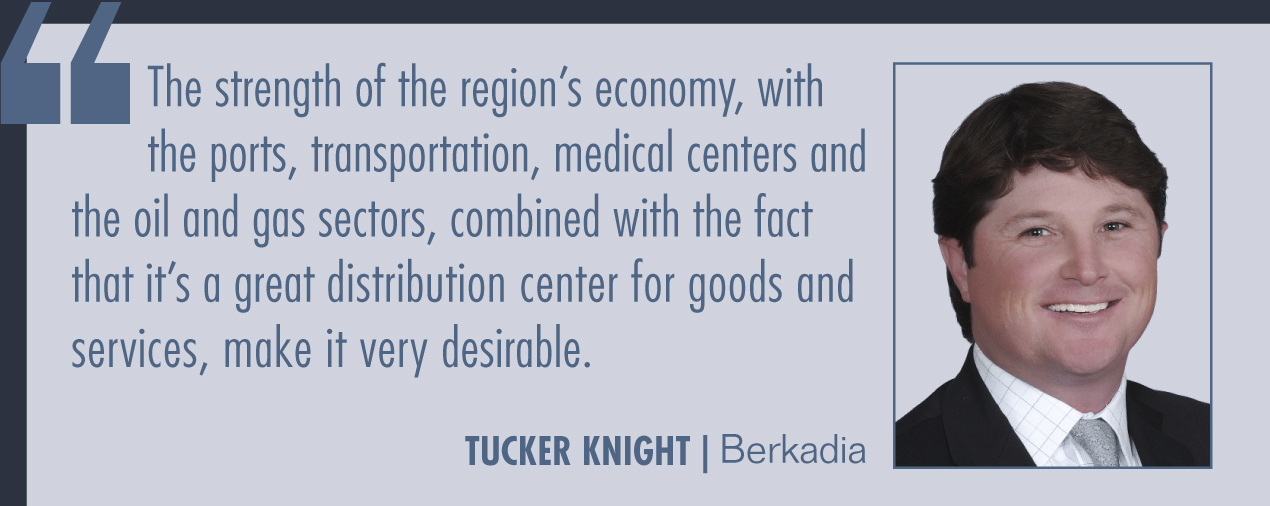 With office, residential and retail components, Dallas' new Park District development is part of the mixed-use trend sweeping the region and country.
With office, residential and retail components, Dallas' new Park District development is part of the mixed-use trend sweeping the region and country.
There is nary a sector that isn't bursting at the seams in most of the regions of the Southwest. Retail is finding new life within mixed-use developments, multifamily developers can't build fast enough to keep up with demand, office is staying on its toes with creative ways to keep employees engaged, and distribution/warehousing activity is fast and furious.
When analyzing the local economy, fundamentals and trends in the region, one thing is for certain. The Lone Star State is running roughshod over many other states. Entering the eighth year of this real estate cycle, Dallas-Fort Worth, specifically, has shot to the top of the most in-demand markets with record-breaking development. However, Real Estate Forum found that Arizona, Arkansas, Oklahoma and New Mexico are holding their own in many respects. Louisiana is more of a mixed bag.
Indeed, Texas developers have been hard at work. All major metros are represented in the top 25 with respect to construction pipelines—Dallas (six), Austin (nine), Fort Worth (10), Houston (21) and San Antonio (24), says JLL. The current construction pipeline totals 19.2 million square feet and 50% is preleased.
In fourth-quarter 2017, DFW had 38,792 units of multifamily in the construction pipeline, the most of any US metro, according to Axiometrics. These new properties are mainly distributed across Plano, Allen and McKinney, central Oaklawn and the Northwest submarkets of Denton and North Irving—the same areas Moody's Analytics forecasts the bulk of DFW's job growth (83,200 new payrolls) to occur this year.
In 2017, DFW developers delivered 26.8 million square feet of industrial space, a market record, according to CBRE. Meanwhile, the office market gained 8.4 million square feet in the past two years alone. The largest concentration of office construction is located in Far North Dallas and Uptown, both with more than 1 million square feet under construction.
Namely, JP Morgan's headquarters was completed at Legacy West in Plano—the largest of 17 projects finalized in the first quarter of 2018. The 1.4 million-square-foot campus will bring about half of the firm's 12,000 North Texas employees under one roof.
In February, TD Ameritrade opened its new headquarters in Southlake, TX, consolidating staff from the company's North Fort Worth location. On a 78-acre parcel, the 355,000-square-foot project is designed to house up to 2,000 employees.
By mid-year, 16 DFW office projects totaling 4 million square feet are due for completion. Of that, some 504,753 square feet is set to deliver at Liberty Mutual Tower at Legacy West I, followed by another 504,752 square feet at Legacy West II. Liberty Mutual will add 5,000 jobs in Plano when this 1.1 million square feet is delivered.
Other massive projects underway include the 20-story PwC Tower being developed by Trammell Crow at Park District in Uptown with 500,000 square feet, and Frisco's Wade Park/buildings II and III, with 400,000 square feet each.
Many of the larger projects are being constructed at the metro periphery, such as the 1.089 million-square-foot 35 Eagle Building A in Alliance, as infill sites are becoming increasingly rare, says CBRE. And historically concentrated in Far North Dallas, large build-to-suit projects are beginning to appear elsewhere in the market: Pioneer Natural Resources broke ground on its 1.1 million-square-foot campus at Hidden Ridge in Las Colinas and Signet Jewelers moved into its 225,000-square-foot building in Cypress Waters. Meanwhile, American Airlines with 1.8 million square feet, Charles Schwab with 500,000 square feet and Mercedes Benz Financial with 200,000 square feet recently broke ground on the Fort Worth side of the market.
Marketwide, build-to-suit projects accounted for 50% of all industrial development as of Q4 2017, the highest build-to-suit to spec construction ratio yet this cycle. Additionally, an influx of new residents and jobs into DFW, increased adoption of automation and e-commerce/last-mile logistics have resulted in larger super-regional distribution centers.
 High RevPAR growth is fueling investor demand for hotels in Tempe, Scottsdale and Downtown Phoenix, where Apple Hospitality REIT Inc. paid $44 million for this recently completed 210-room Hampton Inn & Suites by Hilton.
High RevPAR growth is fueling investor demand for hotels in Tempe, Scottsdale and Downtown Phoenix, where Apple Hospitality REIT Inc. paid $44 million for this recently completed 210-room Hampton Inn & Suites by Hilton.Despite all of this demand and growth, Texas' top-tier office markets—as with many markets across the country—were off to a slow start this year in terms of investment, wrapping up what may be one of the worst quarters of the past five years. The Texas office market had a total of 22 sales since the beginning of the year, totaling $504 million in sales volume and signaling a 63% year-over-year decline, according to CommercialCafe.
The 5.6 million square feet of inventory in fewer than 30 office transactions was the lowest quarterly total in five years. But, DFW was the most active in quarterly deals closed with 11 sales for $87 million.
Not to be outdone is Houston, which has created a million jobs in 10 years as one of the nation's largest manufacturing metros. Its industrial market remains one of the healthiest in the country, fueled by strong population growth and port activity.
“Everything we have going on here economically with the ports, transportation, the medical centers and the oil-gas sector, and the fact that it's a great distribution center for goods and services going East or West make us a very desirable city to live and invest in,” says Tucker Knight, senior managing director, Berkadia.
With an economy largely focused on products that support oil extraction and refining, distribution and warehousing have picked up the slack as the shale oil production pace has slowed. And, more than a year has passed since the widening of the Panama Canal, resulting in container traffic soaring by 11% last year.
Industrial construction has been very balanced, with demand heading toward spec construction. One of the projects soon to break ground is a 540-acre master-planned multi-modal distribution park in El Campo, TX, with up to 10 million square feet of class-A warehouse, manufacturing and distribution facilities, according to NAI Partners.
Although the office market has struggled with crude oil hovering at the $50 per barrel bull/bear line, it remains one of the best markets for investment in 2018. Investors ranked Houston as a top-five target for investment among US metros, whereby 88% of investors plan to either maintain or increase spending in 2018—up from 83% in 2017.
As a result, investors who purchase assets near the port will drive bidding for properties, according to Marcus & Millichap. The Houston office market concluded first quarter with the highest dollar volume—where assets traded at an average of $144 per square foot. Office assets accounted for 80% of total first quarter Texas office sales—$343 million in disclosed-price transactions.
Not surprisingly, Space City was home to the largest sale of the first quarter. Baupost Group and M-M Properties paid $175 million for the 1.2 million-square-foot Marathon Oil Tower. Sold at 90% occupancy, roughly two-thirds of the property is leased to anchor tenant Marathon Oil through 2021. The new owners plan to spend more than $25 million on upgrading the building located at 5555 San Felipe St.
This transaction is further indication that investors believe the market has bottomed out and are anticipating a solid recovery during the next few years. In addition, lease contracts are leading to significant interest from a broad range of investors seeking attractive fundamentals and solid value-add opportunities in well-located submarkets in Houston.
Austin's emerging tech hub appeal has made it a development cluster contender, with 11 office projects totaling 1.8 million square feet nearing completion. Noteworthy developments include Stonelake's Domain Tower, which is due for completion by mid-year. The 310,000-square-foot North Austin office property will be fully occupied by tech company, Indeed. Other corporate hubs that are nearing completion include the 270,000-square-foot Texas Mutual Insurance Co. headquarters in East Austin and the Charles Schwab headquarters in North Austin, both due by mid-year.
In Phoenix, robust growth is perhaps signaling too much of a good thing. “The market in Phoenix is strong, to the point that it is a concern,” says George Forristall, director of real estate development at Mortenson. “Demand is outstripping supply in many instances. For example, multifamily continues to be a strong play longer than anticipated.”
Forristall cites downtown Phoenix, Tempe and Scottsdale, where continued high-rise multifamily and hotel RevPAR growth point to demand. In addition, Westside industrial is also in contention, where that submarket includes an abundance of antiquated space.
“Office is creeping back in the Camelback Corridor and downtown Phoenix, where there are new developments,” Forristall says. “But we have to look at developing creatively. Mixed use and reuse are an absolute necessity.”
Don Morrow, an SVP at NAI Horizon, had similar views about the dizzying pace of the Phoenix market. Morrow points to the timeframe between March 2017 and 2018 when Maricopa County was the fastest-growing US county, adding 73,650 new residents. In that same timeframe, the Phoenix MSA added 65,000 new jobs to the civilian labor force.
“The economy is the fuel that propels the real estate engine and right now as we look at the fuel gauge, the tank is pretty full,” says Morrow. “We've had sustained job growth for some time now and the number of people employed in our area is the highest number in history. Much of the growth is organic as companies already here continue to expand. However, much of the growth is from California companies relocating to Arizona primarily because it is a less expensive business environment.”
The MSA's real estate fundamentals are strong and getting better, Morrow adds, resulting in a robust investment climate.
“An area to watch is the current amount of office space under construction, at just over 2 million square feet of speculative office space,” he points out. “As a result of these strong fundamentals, the investment climate in Arizona is very bright. This will be aided by an abundance of capital seeking to invest in Arizona and plentiful affordable financing being available to facilitate these acquisitions. The issue, however, is a shortage of investment properties for sale, creating a supply-demand imbalance strongly favoring the sellers.”
Morrow indicates that the number of office transactions were down in total dollar volume from a peak in 2015. In industrial, the number of transactions dropped 53% from 2015 to 2017. The dollar volume in industrial peaked in 2016 and was off by 36% in 2017. Despite the lower deal rate, industrial remains in demand due to e-commerce popularity, he says.
Meanwhile, the Oklahoma economy, although increasingly diverse, is still heavily impacted by the energy sector.
“The downturn in the oil and gas industry in recent years slowed economic growth which in turn limited landlords' ability to raise rents and aggressively increase occupancies,” observes Jordan Cortez, managing principal, Vanguard Real Estate Advisors. “However, the energy market has made great strides of late and according to many industry prognosticators, this should only continue, which will bode well for Oklahoma as a whole and specifically the real estate community.”
To encapsulate the strengthening economy, the year-over-year unemployment data (February 2018) for the two largest metros via the Bureau of Labor Statistics tells the story. Tulsa's unemployment rate improved by 90 basis points to 4.1% and Oklahoma City improved by 60 basis points to 3.7%.
“The positive looking forward is that Oklahoma City developers have scaled back new starts and currently there are only five conventional multifamily projects under construction, which will translate to positive absorption,” Cortez observes.
The pool of qualified multifamily investors is rapidly expanding as a number of new participants enter the marketplace. Many of these investors are focused on acquiring pre-1990s vintage workforce housing, says Cortez.
“They are bullish on the statewide economy with the energy sector's improved outlook, as well as the perception that they can achieve a better going-in cap rate and price per pound metrics than in nearby states such as Texas and Colorado,” he relates. “With the improving property fundamentals, strengthening Oklahoma economy, improved investor sentiment and attractive yields as compared to other major metros, a perfect storm has been created for the Oklahoma multifamily markets which we expect to translate into a sizeable uptick in sales volume across the state.”
Arkansas added 16,100 jobs in 2017, with the majority contributed by education, health services and manufacturing. This positive gels well for significant growth in the industrial market.
“Even as manufacturing job growth most certainly translates into industrial real estate space gains, the real bread and butter for the Oklahoma/Arkansas industrial real estate in this cycle has been consumer goods,” says Cary Phillips, a CBRE managing director for Oklahoma and Arkansas. “Job growth across the region drastically increases the demand on consumer goods, adding the need for more space to handle the production and logistics of products to the expanded consumer base in Oklahoma and Arkansas.”
Multifamily leads transactions in Arkansas with a rolling 12-month total of $364.7 million. The most notable difference between the two states is the appetite for office product is stronger in Arkansas and currently is the second most-preferred property type with $197.2 million during the same time period, Phillips says.
Looking forward, demand for large space in Albuquerque remains strong, specifically in the education industry and business services industry. The 11,000-square-foot addition to the Century Link building remained under construction in second quarter, the only new construction project, according to CBRE.
With slower activity and a handful of closures, Valencia County, NM had 60,000 square feet of industrial completions added to an existing manufacturing facility. A 970,000-square-foot data center remained under construction with expected completion of fourth quarter 2018.
New Orleans' ProsperityNOLA is billed as a catalyst for economic transformation in the city's tricentennial this year. At the same time, Stephen Waguespack, president and CEO of Louisiana Association of Business and Industry, acknowledged the state's lagging economy, but said southwest Louisiana was leading the rest of the state due to billions in current and announced industrial development projects.
There are currently 92 industrial properties for sale in the New Orleans/Metairie MSA, the same total as one year ago. The average industrial property is on the market for 322 days, according to Louisiana Commercial Realty. Sale prices for industrial space averaged $40 per square foot as of April 2018, down from 8.5% in the prior month. The supply of industrial investment property increased 6% or by 183,000 square feet. During the past year, industrial sale prices increased 24% while supply decreased 217,000 square feet.
Office sales prices in the New Orleans/Metairie MSA averaged $105 per square foot as of April 2018, down 3.5% in the previous month, according to Louisiana Commercial Realty. During the past year, office prices increased 2.8% while supply increased 183,296 square feet.
The answer to whether many of these metros can continue at this lightning speed is anyone's guess. But the upside is that much of the building is in response to demand, which is a welcome respite from the no-holds-barred days of the past.
© Touchpoint Markets, All Rights Reserved. Request academic re-use from www.copyright.com. All other uses, submit a request to [email protected]. For more inforrmation visit Asset & Logo Licensing.









